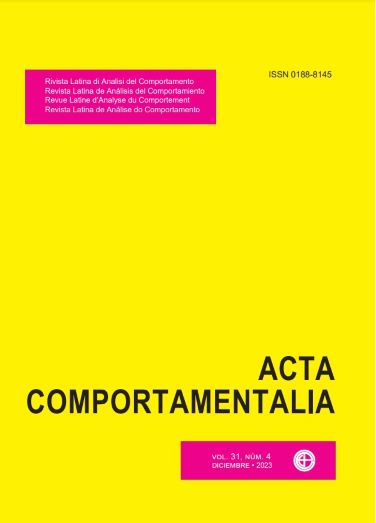Stimulus Equivalence with compound stimuli in a boy with autism
Main Article Content
Abstract
The objective of this study was to verify the effect of matching-to-sample training with compound sample stimuli (MTS-C) on the emergence of relations between stimuli by the individual elements of the samples. The participant was a 6-year-old boy diagnosed with Autism Spectrum Disorder. The stimuli were corresponding Libras signs (A), dictated names (B), written words (C) and pictures (D) of animals. A multiple-baseline design across three-stimulus sets was used by testing transitive relations CD and DC. After initial baseline testing, relations AB-C and AB-D were taught for the first stimulus set. After reaching the learning criterion for AB-C and AB-D, emergent relations (AB, BA, AC, CA, AD, DA, BC, CB) were tested for the first stimulus set and transitive relations (CD, DC) were tested for the three stimulus sets. That sequence was then repeated for the other sets. Teaching and testing were all applied with an educational computer program. The results indicated that the participant learned all the taught relations and the emergence of some relations not directly taught. The number of trial blocks to reach the learning criterion decreased throughout the procedure (78 blocks for the first set, 58 for the second and 22 for the last set). The percentage of correct responses at baseline varied between 30 and 40% for CD and DC relations. In the tests applied immediately after teaching AB-C and AB-D for the first set, the participant presented 80% correct responses for CD and DC first set relations, while the percentage of correct responses remain the same for the other sets. In the tests applied immediately after teaching AB-C and AB-D for the second set, the participant presented, respectively, 50 and 60% correct responses for CD and DC second set relations, while the percentage of correct responses remain the same for the last set. In the tests applied immediately after teaching AB-C and AB-D for the third set, the participant presented same percentage of correct responses for CD and DC third set relations as in baseline. These results do not allow us to state that the participant formed all the classes planned in the study. Besides, maintenance data suggest that performance was not maintained, because percentage of correct responses for CD and DC relations returned to baseline condition. These results differ from those found previously in the literature, in which one participant demonstrated formation of equivalent stimulus classes. Data are discussed based on other literature papers and the differences among the studies. The differences are in the participant’s input repertoire (the participant in this study was not a sign language user), the structure of the teaching blocks (gradual introduction of the number of sample and comparison stimuli) and the number of relations tested (ten relations).
Article Details
Citas en Dimensions Service

<a rel="license" href="http://creativecommons.org/licenses/by-nc-sa/4.0/"><img alt="Licencia de Creative Commons" style="border-width:0" src="https://i.creativecommons.org/l/by-nc-sa/4.0/88x31.png" /></a><br />Este obra está bajo una <a rel="license" href="http://creativecommons.org/licenses/by-nc-sa/4.0/">licencia de Creative Commons Reconocimiento-NoComercial-CompartirIgual 4.0 Internacional</a>.
